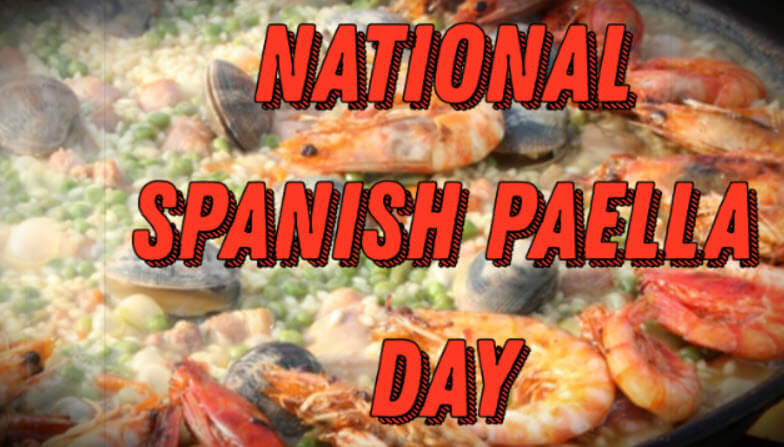Discover 7 exciting ways to celebrate National Spanish Paella Day, from cooking and tasting paella to taking a cooking class, visiting a Spanish restaurant, sharing your experience on social media, and more!

National Spanish Paella Day is an unofficial food holiday that is observed on March 27th each year. It is a day to celebrate the traditional Spanish dish known as paella, which is a rice-based dish that typically includes saffron, chicken, seafood, and vegetables. Paella originated in the Valencia region of Spain and has become a popular dish around the world. On National Spanish Paella Day, people may celebrate by cooking and enjoying paella, sharing recipes and pictures of the dish on social media, or attending events or festivals that feature paella.
History of National Spanish Paella Day
As far as my knowledge goes, the origin and history of National Spanish Paella Day are unclear. It appears to be an unofficial food holiday that was created by enthusiasts and fans of Spanish cuisine to celebrate and promote the traditional dish of paella. The dish has been around for centuries and is an integral part of Spanish culture, especially in the Valencia region where it originated. However, the specific date of March 27th and the creation of the holiday itself are not associated with any significant historical or cultural event. It is likely that the holiday was created as a way to honor and celebrate the dish and promote awareness and appreciation of Spanish cuisine.
How to Celebrate National Spanish Paella Day
Here are some ways you can celebrate National Spanish Paella Day:
- Cook and enjoy paella: You can celebrate by cooking a traditional paella dish at home or with friends and family. There are many variations of paella, so you can choose the ingredients and flavors that you prefer.
- Order paella at a restaurant: If you don’t feel like cooking, you can celebrate by visiting a Spanish restaurant that serves paella. This is a great way to try different variations of the dish and support local businesses.
- Attend a paella festival: Many cities around the world hold paella festivals, especially during the summer months. These festivals feature paella cooking competitions, live music, and cultural activities.
- Share paella recipes and pictures on social media: You can celebrate National Spanish Paella Day by sharing your favorite paella recipe or picture of a paella dish on social media using the hashtag #NationalSpanishPaellaDay.
- Learn about Spanish culture and cuisine: Take the opportunity to learn more about Spanish culture and cuisine, especially the history and traditions of paella. You can read books, watch documentaries, or attend cultural events in your area.
Plan a Trip to Valencia, the Home of Spanish Paella
Valencia is a beautiful city located on the eastern coast of Spain and is considered to be the birthplace of paella. Here are some tips for planning a trip to Valencia to experience the best of Spanish cuisine and culture:
- Visit the Central Market: The Central Market of Valencia is a popular destination for foodies and a great place to sample local produce and ingredients for paella.
- Take a cooking class: Many cooking schools in Valencia offer paella cooking classes where you can learn the traditional way to prepare the dish.
- Visit the City of Arts and Sciences: This modern architectural wonder is one of the most popular tourist attractions in Valencia and features several museums, an aquarium, and an IMAX cinema.
- Explore the Old Town: The old town of Valencia is full of narrow streets, charming plazas, and historic buildings. You can visit the Cathedral of Valencia, climb the Micalet Bell Tower for panoramic views of the city, or stroll through the vibrant Barrio del Carmen neighborhood.
- Enjoy the Beach: Valencia has a long stretch of beautiful beaches that are perfect for relaxing and soaking up the sun.
- Attend a paella festival: Valencia hosts several paella festivals throughout the year, including the World Paella Day celebration in September.
- Try the local drinks: Valencia is famous for its horchata, a refreshing drink made from tiger nuts, and its wine from the nearby Utiel-Requena region.
Valencia is a great destination for foodies and those who want to experience Spanish culture and history. By planning your trip around paella and the local cuisine, you can have an unforgettable and delicious vacation.
National Spanish Paella Day Activities
Here are some activities you can do to celebrate National Spanish Paella Day:
- Cook paella at home: Gather some friends and family to cook a traditional paella recipe at home. You can choose a recipe that features seafood, chicken, or vegetables, depending on your preferences.
- Host a paella party: If you don’t feel like cooking, you can host a paella party and ask your guests to bring their favorite paella dish to share. This is a great way to sample different recipes and enjoy the company of friends and family.
- Visit a Spanish restaurant: Visit a Spanish restaurant that specializes in paella and order a variety of paella dishes to try. Don’t forget to pair it with a glass of Spanish wine or a refreshing sangria.
- Take a cooking class: Look for a cooking school in your area that offers paella cooking classes. You can learn the traditional way to prepare the dish and take your skills back home to impress your friends and family.
- Share your paella experience on social media: Share pictures of your paella dishes or your paella cooking experience on social media using the hashtag #NationalSpanishPaellaDay.
- Watch a movie or documentary about Spanish cuisine: Take the opportunity to learn more about Spanish cuisine and culture by watching a movie or documentary that focuses on paella or Spanish cuisine.
Read a book about Spanish cuisine: There are many great books that focus on Spanish cuisine and the history of paella. You can learn about the traditional ingredients and cooking techniques used to prepare this iconic dish.